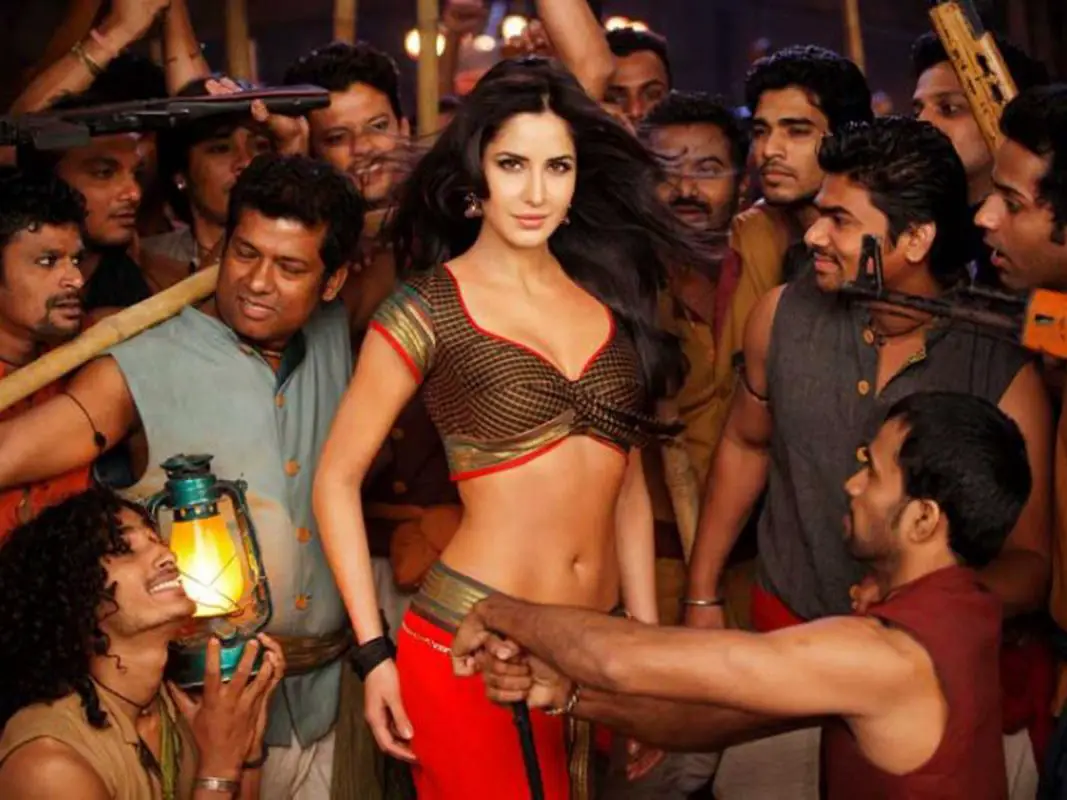On a stage lit in blue and red is a circular bed with too many throw pillows for any one woman — this is part of the set for one of the most legendary Bollywood item numbers in modern times, “Sheila Ki Jawani.”
On the bed is Katrina Kaif, one of the most popular modern Bollywood actresses, dressed in nothing but the sheets, which she holds clasped to her chest as several buff men dressed in black begin to dance with her. Every few seconds, the shot switches from Kaif to other men who get increasingly drunk, to the point where one, the hero, hijacks her song and charms her.
When this song came out, I was a kid, and it became a phenomenon overnight. The clever chorus’ second line is, “I’m too sexy for you,” and none of us could say that without giggling. It exposed me and many others to the niche Bollywood world of the item number — a song within a film that carries grave implications for how the Indian subcontinent perceives its women and how these women perceive themselves.
The Bollywood film, a genre most closely associated with musical comedy, has never quite been known as a progressive institution. It has been setting expectations for heterosexual romance for generations and tends to shirk its responsibility as an art form to represent the diverse demographic to which it caters. The item number is a relatively new phenomenon; it only became commonplace within the last decade or so, and “Sheila Ki Jawani” was a huge factor.
These song sequences with meaningless lyrics tend to have very little relevance to the plot of any given film and typically feature a heavily sexualized female lead. This woman most likely will not have any other role in the film other than to temporarily seduce the male lead and, generally, be a ditz.
Her function is restricted to her four-minute song, where you’ll find her typically clad in very little clothing that still draws on the designs of traditional Indian garments. She galvanizes the many unnamed men around her with her body; they drink to it and cheer for it and her seductive look to the camera implies that we, the audience, are meant to do the same.
Why take up valuable screen time with a seemingly pointless song and dance sequence? Typically, none of the people in the film — not even the male lead around whose victory and virility the song is centered — are defined or characterized in any significant way. Item numbers do very little, if anything, to set the scene or provide expositional detail. What, beyond erotica, is the point of these numbers? And what is their effect beyond the films in which they reside?
The social structure in India is a mystery to few: The “hypermasculinity and male dominance” of the country, as put by an article on the Tempest, has its roots in things like religious tradition. To oversimplify it, the position of women in a modern-day Indian society is precarious at best, unless she is wealthy and from a good lineage.
The traditional view of women as homemakers, nothing more than wives and mothers at their prime, persists heavily both in India and among Indian diaspora — in other words, the chief consumers of Bollywood film.
Typically, Bollywood film responds to market forces in a shameless way: They make what’s popular, and when that becomes popular too, they make it again. This keeps the mainstream strand of the genre from branching out whatsoever — with the exception, perhaps, of some very recent films — into innovation and representation that isn’t trite and tropey.
This is because the Bollywood film is an avenue for escapism. The item numbers in particular depict dreamlike desire and perfection that Bollywood is notorious for. To top it off, Bollywood implies that this perfection is available to the common man, who shows up in music videos in dozens of avatars with various bottles in his hand, eyes fixed on the woman in the center of the room.
This has grave psychological implications. By imbuing the common Indian man with power and agency over a woman who very obviously enjoys his leering and yelling, Bollywood is affirming the already lethally misogynistic culture of the subcontinent. And while misogyny and rape culture can’t be chalked up solely to the movie industry, it remains an important soft power in shaping the attitudes of its audience: not just what men think of women, but of what women think of themselves.
In a relatively inflexible culture, item numbers corroborate long-standing opinions of younger women as sex objects. They are reduced to “whirling [pieces] of meat,” as the Tempest article says.
Classics like “Sheila Ki Jawani” and some of its counterparts, “Fevicol Se” and “Munni Badnaam Hui” have been problematic since their conception, but little has changed in the item number industry. A recent iteration of this genre that includes the same tendencies without apology is “Chamma Chamma” featuring dancer Elli AvrRam. The opening shots are of AvrRam in colorful but minimal traditional clothes topped by a black hooded cape, like a dominatrix.
Sparks literally fly in the background as she walks in slow motion onto a platform. A much older man, Arshad, watches her from the sidelines, pounding shots. Halfway through the song, he begins singing too, and the next shot has AvrRam perched on the bar top, her hand curled in his sweater vest as she welcomes his desire. The camera slowly and sensually pans up and down AvrRam’s body, putting her on display, welcoming the male gaze — and not just his gaze, but his action, his control.
These sensual camera movements are a key facet of item numbers. “Gali Gali,” released around the same time, adds to the legacy of item numbers as places of voyeurism. This song speaks to another item number trope: interspersing sexy dance sequences with manly, testosterone fueled fight scenes, complete with much bloodshed and guns.
This construction reveals exactly what is so valuable in this four-minute sequence that takes up precious screen time. Item numbers don’t just affirm gender roles, they glorify them. The woman is praised raucously for her sexual prowess and desirability; the man is revered for his forwardness and aggression.
The audience, meanwhile, is entertained — attractive stimuli are coming at them from all directions, intended to thrill, arouse and excite. The marketability of the item number sequence is, in short, through the roof.
But capitalizing and profiting off of women’s bodies and systems of oppression is indefensible, especially in 2020. It’s time Bollywood moved on from showcasing the easy things — with its global reach and legacy, it has the potential to be the vehicle of serious change. And I, for one, believe in its power.

















